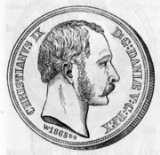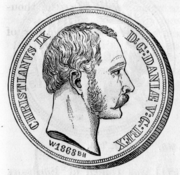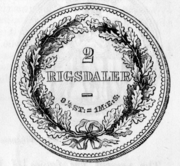
Danish rigsdaler
Encyclopedia
The rigsdaler was the name of several currencies used in Denmark
until 1873. The similarly named Reichsthaler
, riksdaler and rijksdaalder were used in Germany
and Austria-Hungary
, Sweden
and the Netherlands
, respectively.

 The Danish currency system established in 1625 consisted of 12 penning
The Danish currency system established in 1625 consisted of 12 penning
= 1 skilling, 16 skilling = 1 mark
, 6 mark = 1 rigsdaler and 8 mark = 1 krone.http://www.globalfinancialdata.com/index.php3?action=showghoc&country_name=DENMARK From 1713, two separate systems coexisted, courant and species, with courant being a debased currency also used for banknote issue. The rigsdaler species contained of a Cologne mark
of fine silver (i.e., 9¼ rigsdaler species equalled one Cologne mark).
In 1813, following a financial crisis, a new currency system was introduced, based on the rigsbankdaler. This was divided into 96 rigsbank skilling and was equal to half a rigsdaler species or 6 rigsdaler courant.
A further change was made in 1854. The rigsdaler species name disappeared and the names rigsbankdaler and rigsbank skilling became rigsdaler and skilling rigsmønt. Thus, there were 96 skilling rigsmønt to the rigsdaler.
In 1873, Denmark and Sweden formed the Scandinavian Monetary Union
and the rigsdaler was replaced by the Danish krone
. An equal valued krone/krona of the monetary union replaced the three currencies at the rate of 1 krone/krona = ½ Danish rigsdaler = ¼ Norwegian speciedaler
= 1 Swedish riksdaler
. Today, a tokrone (coin worth 2 kroner) is thus occasionally referred to as a daler.
Between 1813 and 1815, copper coins bearing the legend "rigsbanktegn" ("rigsbank token") were issued in denominations of 2, 3, 4, 6, 12 and 16 skilling. From 1818, 1, 2 and 32 rigsbank skilling coins were issued, with 1 rigsdaler species from 1820. From 1826, gold coins were issued denominated in "Frederiks d'Or" or "Christians d'Or" (depending on the name of the ruling king). The "d'or" was nominally worth 10 rigsdaler, although the currency was on a silver standard. In 1838, ½ rigsbank skilling coins were introduced.
Between 1840 and 1843, a new coinage was introduced, consisting of , ½, 1, 2, 3, 4, 8, 16 and 32 rigsbank skilling, 1 rigsbankdaler and 1 rigsdaler species. Denominations between 4 rigsbank skilling and 1 rigsbankdaler were also inscribed with the denomination in the currency of Schleswig-Holstein
, the Schilling Courant, of which there were 60 to the Speciethaler
, equal to the rigsdaler species. These denominations were 1¼, 2½, 5, 10 and 30 Schilling Courant.
The renaming of the currency units in 1854 lead to the issuing of coins for ½, 1, 4 and 16 skilling rigsmønt, 1 and 2 rigsdaler. Gold "d'or" coins continued to be issued (see above).
In 1813, the Rigsbank introduced notes in denominations of 1, 5, 10, 50 and 100 rigsbankdaler. These were followed, in 1819, by notes of the National Bank in the same denominations. After the change in name of the currency, the National Bank issued notes for 5, 10, 20, 50 and 100 rigsbankdaler.
Denmark
Denmark is a Scandinavian country in Northern Europe. The countries of Denmark and Greenland, as well as the Faroe Islands, constitute the Kingdom of Denmark . It is the southernmost of the Nordic countries, southwest of Sweden and south of Norway, and bordered to the south by Germany. Denmark...
until 1873. The similarly named Reichsthaler
Reichsthaler
The Reichsthaler was a standard Thaler of the Holy Roman Empire, established in 1566 by the Leipzig convention. It was also the name of a unit of account in northern Germany and of a silver coin issued by Prussia.-Reichsthaler coin:...
, riksdaler and rijksdaalder were used in Germany
Germany
Germany , officially the Federal Republic of Germany , is a federal parliamentary republic in Europe. The country consists of 16 states while the capital and largest city is Berlin. Germany covers an area of 357,021 km2 and has a largely temperate seasonal climate...
and Austria-Hungary
Austria-Hungary
Austria-Hungary , more formally known as the Kingdoms and Lands Represented in the Imperial Council and the Lands of the Holy Hungarian Crown of Saint Stephen, was a constitutional monarchic union between the crowns of the Austrian Empire and the Kingdom of Hungary in...
, Sweden
Sweden
Sweden , officially the Kingdom of Sweden , is a Nordic country on the Scandinavian Peninsula in Northern Europe. Sweden borders with Norway and Finland and is connected to Denmark by a bridge-tunnel across the Öresund....
and the Netherlands
Netherlands
The Netherlands is a constituent country of the Kingdom of the Netherlands, located mainly in North-West Europe and with several islands in the Caribbean. Mainland Netherlands borders the North Sea to the north and west, Belgium to the south, and Germany to the east, and shares maritime borders...
, respectively.
History


Pfennig
The Pfennig , plural Pfennige, is an old German coin or note, which existed from the 9th century until the introduction of the euro in 2002....
= 1 skilling, 16 skilling = 1 mark
Mark (money)
Mark was a measure of weight mainly for gold and silver, commonly used throughout western Europe and often equivalent to 8 ounces. Considerable variations, however, occurred throughout the Middle Ages Mark (from a merging of three Teutonic/Germanic languages words, Latinized in 9th century...
, 6 mark = 1 rigsdaler and 8 mark = 1 krone.http://www.globalfinancialdata.com/index.php3?action=showghoc&country_name=DENMARK From 1713, two separate systems coexisted, courant and species, with courant being a debased currency also used for banknote issue. The rigsdaler species contained of a Cologne mark
Cologne mark
The Cologne Mark was a unit of weight equivalent to 233.856 grams. It was introduced by the Danish King Hans in the late 15th century and was used as a standard for weighing metals...
of fine silver (i.e., 9¼ rigsdaler species equalled one Cologne mark).
In 1813, following a financial crisis, a new currency system was introduced, based on the rigsbankdaler. This was divided into 96 rigsbank skilling and was equal to half a rigsdaler species or 6 rigsdaler courant.
A further change was made in 1854. The rigsdaler species name disappeared and the names rigsbankdaler and rigsbank skilling became rigsdaler and skilling rigsmønt. Thus, there were 96 skilling rigsmønt to the rigsdaler.
In 1873, Denmark and Sweden formed the Scandinavian Monetary Union
Scandinavian Monetary Union
The Scandinavian Monetary Union was a monetary union formed by Sweden and Denmark on May 5, 1873, by fixing their currencies against gold at par to each other...
and the rigsdaler was replaced by the Danish krone
Danish krone
The krone is the official currency of the Kingdom of Denmark consisting of Denmark, the Faroe Islands and Greenland. It is subdivided into 100 øre...
. An equal valued krone/krona of the monetary union replaced the three currencies at the rate of 1 krone/krona = ½ Danish rigsdaler = ¼ Norwegian speciedaler
Norwegian speciedaler
The speciedaler was the currency of Norway between 1816 and 1875. It replaced the rigsdaler specie at par and was subdivided into 120 skilling . It was replaced by the Norwegian krone when Norway joined the Scandinavian Monetary Union...
= 1 Swedish riksdaler
Swedish riksdaler
The riksdaler was the name of a Swedish coin first minted in 1604. Between 1777 and 1873, it was the currency of Sweden. The daler, like the dollar, was named after the German Thaler. The similarly named Reichsthaler, rijksdaalder, and rigsdaler were used in Germany and Austria-Hungary, the...
. Today, a tokrone (coin worth 2 kroner) is thus occasionally referred to as a daler.
Coins
In the late 18th century, coins were issued in denominations of ½, 1, 2, 4, 8, 24 and 32 skilling, , ¼, ⅓, ½ and 1 rigsdaler specie.Between 1813 and 1815, copper coins bearing the legend "rigsbanktegn" ("rigsbank token") were issued in denominations of 2, 3, 4, 6, 12 and 16 skilling. From 1818, 1, 2 and 32 rigsbank skilling coins were issued, with 1 rigsdaler species from 1820. From 1826, gold coins were issued denominated in "Frederiks d'Or" or "Christians d'Or" (depending on the name of the ruling king). The "d'or" was nominally worth 10 rigsdaler, although the currency was on a silver standard. In 1838, ½ rigsbank skilling coins were introduced.
Between 1840 and 1843, a new coinage was introduced, consisting of , ½, 1, 2, 3, 4, 8, 16 and 32 rigsbank skilling, 1 rigsbankdaler and 1 rigsdaler species. Denominations between 4 rigsbank skilling and 1 rigsbankdaler were also inscribed with the denomination in the currency of Schleswig-Holstein
Schleswig-Holstein
Schleswig-Holstein is the northernmost of the sixteen states of Germany, comprising most of the historical duchy of Holstein and the southern part of the former Duchy of Schleswig...
, the Schilling Courant, of which there were 60 to the Speciethaler
Schleswig-Holstein speciethaler
The Speciethaler was the currency of Schleswig-Holstein until 1866. It was divided into 60 Schilling Courant, each of 12 Pfennig. The Speciethaler was equal to the Danish rigsdaler specie. From 1842, Danish coins were issued denominated in both rigsbank skilling and schilling courant, for use in...
, equal to the rigsdaler species. These denominations were 1¼, 2½, 5, 10 and 30 Schilling Courant.
The renaming of the currency units in 1854 lead to the issuing of coins for ½, 1, 4 and 16 skilling rigsmønt, 1 and 2 rigsdaler. Gold "d'or" coins continued to be issued (see above).
Banknotes
In 1713, the government introduced notes for 1, 2 and 3 mark, 1, 5, 10, 25, 50 and 100 rigsdaler. The Copenhagen Assignation, Exchange and Loans Bank issued notes between 1737 and 1804 for 10, 20, 30, 40, 50 and 100 rigsdaler courant. Between 1791 and 1797, the Danish-Norwegian Specie Bank issued notes for 4, 8, 20, 40 and 80 rigsdaler specie. The treasury issued notes for 2 and 20 rigsdaler courant in 1808, followed by 8, 12 and 24 skilling notes in 1809-1810.In 1813, the Rigsbank introduced notes in denominations of 1, 5, 10, 50 and 100 rigsbankdaler. These were followed, in 1819, by notes of the National Bank in the same denominations. After the change in name of the currency, the National Bank issued notes for 5, 10, 20, 50 and 100 rigsbankdaler.

